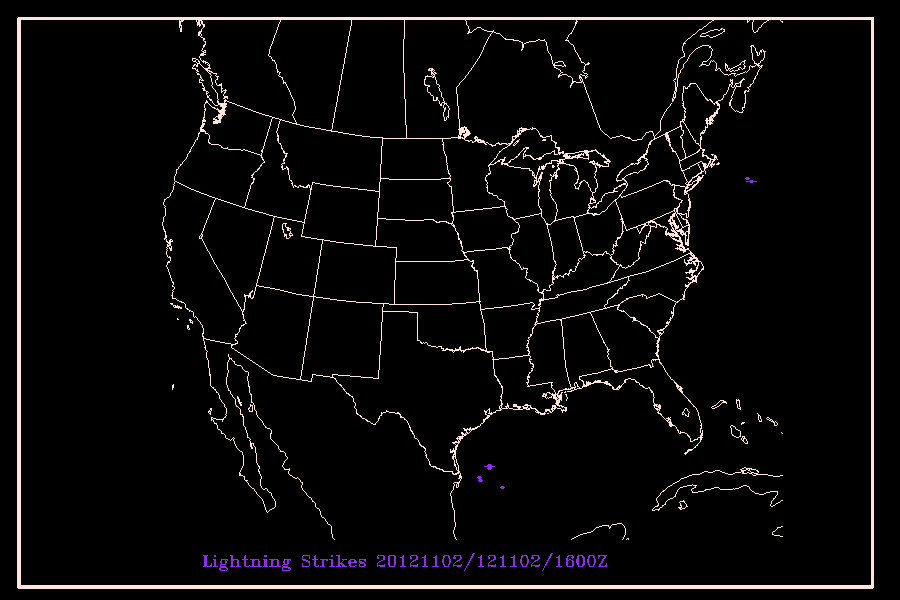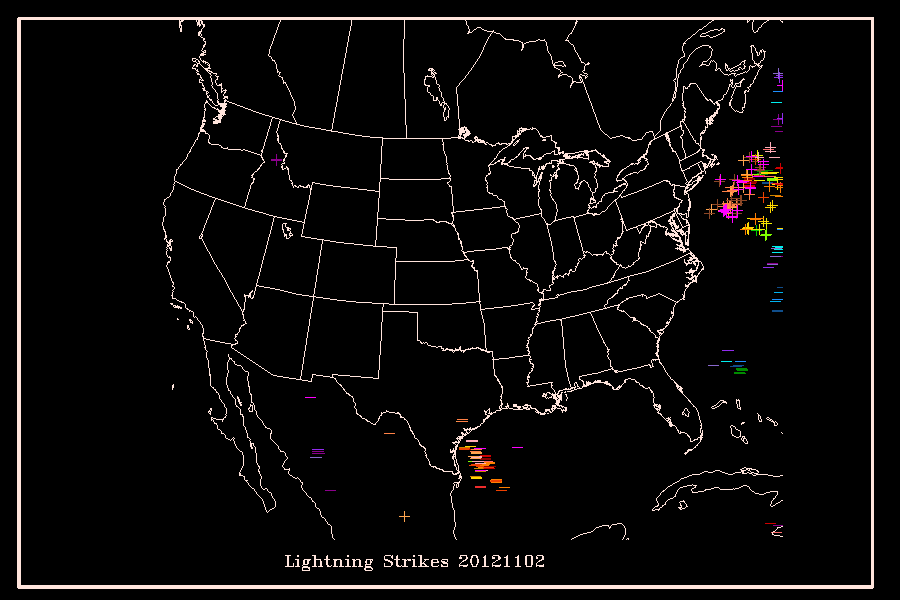
Here we will build an script that may be used either interactively, or as a batch script. While you may not wish to run this script at your site, you should be able to apply your knowledge of GEMPAK and similar principles to either create your own scripts, or to modify those provided with the GEMPAK distribution.
We will build this script in pieces so that you may follow more easily.
Create a shell script to allow the user to interactively (graphically) select the area they wish to use for eventual application:
#!/bin/csh -f
gpmap << SELECT
garea = usnps
proj = str/90;-100;0
map = 6
title = 5/-1/Select Map Area
dev = xw|GAREA SELECTION
clear = y
\$mapfil = hipowo.gsf
r
cursor garea
e
SELECT
gpend
exit(0)
Now modify the shell script above to be run either interactively, or by specifying the area on the command line with the shell invocation.
#!/bin/csh -f
if(x${1} != x) then
gpmap << SELECT1
garea = $1
e
SELECT1
else
gpmap << SELECT2
garea = usnps
proj = str/90;-100;0
map = 6
title = 5/-1/Select Map Area
dev = xw|SELECT_AREA
clear = y
\$mapfil = hipowo.gsf
r
cursor garea
e
SELECT2
gpend
endif
exit(0)
Expand your script to plot the location of lightning strikes for the desired area for the current hour today. Use MARK to plot a suitably sized circle for each lightning location.
#!/bin/csh -f
# set directory of lightning data
set NLDN=$GEMDATA/nldn
# set the current year, month day
set YMD=`date -u '+%Y%m%d'`
# set the current HOUR
set HOUR=`date -u '+%H'`
# get the day of week, month abbrev., day and 4 digit year for title
set TITLE = `date -u '+%A %B %d, %Y'`
# There may be more than 1 NLDN file for each hour...we store ours
# at 30 minute intervals. Alternatively, if more that the maximum number
# of strikes that can be stored in a single file is exceeded, then
# an additional file is opened (see the dcnldn template @@).
# The file naming expected can be one of:
# YYYYMMDDHHNN_@@_nldn.gem
# YYYYMMDDHHNN_nldn.gem
# YYYYMMDDHH_@@_nldn.gem
# YYYYMMDDHH_nldn.gem
set FILES=`ls $NLDN/${YMD}${HOUR}*_nldn.gem`
if($#FILES > 0) then
foreach FILE ($FILES)
# Data may be binned hourly, or at other intervals. We assume 5 minute bins.
# We could use dattim=all (but that will generate a loop using XW
# instead, plot the data for each time in the file, setting clear=no
# after the first time in the file.
set TIMES=`sfctime $FILE`
foreach TIME ($TIMES)
sfmap << EOF
map = 1
dev = xw|"lightning strikes"
proj = nps
area = dset
filter = no
garea = us
clear = yes
text = 1.2/23/1/hw
title = 5/-2/Lightning Strikes ${YMD}/${TIME}Z
panel = .02;.02;.97;.97/1/1/4
sffile = $FILE
sfparm = sgnl;mark:15:3:1
color = 0;30
dattim = $TIME
r
e
EOF
end
end
endif
exit(0)
Use the SGNL parameter stored in the NLDN file to plot stikes with SGNL < -400 with a -, SGNL > 400 with a +, and values from -400 to 400 with a dot.
…
foreach TIME ($TIMES)
sfmap << EOF
map = 1
dev = xw|"lightning strikes"
area = dset
filter = no
clear = yes
garea = us
text = 1.2/23/1/hw
title = 1/-2/Lightning Strikes ${YMD}/${TIME}Z
panel = .02;.02;.97;.97/1/1/4
sffile = $FILE
color = 0;30
dattim = $TIME
sfparm = sgnl<-400;mark:22:1:1
r
clear = no
sfparm = sgnl>400;mark:1:1:1
r
sfparm = sgnl > -401 < 401;mark:15:2:1
r
e
EOF
...
Using the result from #3 above, create a gif image for each hour today. Use a different color for each hour.
You'll need to set the above block within a loop for $HOUR and increment $COLOR with @ COLOR = $COLOR - 4.
Limit the animation to the last 2 hours with the inclusion of a definition set HRSB = 2:
#!/bin/csh -f
# hour setback
set HRSB = 2
# This is the directory of our lightning data
set NLDN=$GEMDATA/nldn
# set the current year, month day
set YMD=`date -u '+%Y%m%d'`
# get the day of week, month abbrev., day and 4 digit year for title
set INC = 1
set CURHR = `date -u '+%H'`
if($CURHR < $HRSB) then
@ HOUR = 23 - $HRSB - $CURHR
@ STOP_HOUR = ($CURHR + 23 ) % 23
else
@ HOUR = $CURHR - $HRSB
@ STOP_HOUR = $CURHR
endif
@ COLOR=29
while($HOUR <= $STOP_HOUR)
if($HOUR < 10) then
set SFHOUR=0${HOUR}
else
set SFHOUR=${HOUR}
endif
set FILES=`ls $NLDN/${YMD}${SFHOUR}*_nldn.gem`
if($#FILES > 0) then
foreach FILE ($FILES)
set TIMES=`sfctime $FILE`
foreach TIME ($TIMES)
set DEV = 'gif|lightning_'${YMD}'_'${INC}.gif'|900;600'
if($INC < 10) then
set DEV = 'gif|lightning_'${YMD}'_0'${INC}.gif'|900;600'
endif
sfmap << EOF
map = 1
garea = us
proj = str/90;-100;0
\$mapfil = hipowo.gsf
dev = ${DEV}
area = dset
filter = no
clear = y
text = 1.2/23/1/hw
title = ${COLOR}/-2/Lightning Strikes ${YMD}/${TIME}Z
panel = .02;.02;.97;.97/1/1/4
sffile = $FILE
color = 0;${COLOR}
dattim = $TIME
sfparm = sgnl<-400;mark:22:1:1
r
clear = no
sfparm = sgnl>400;mark:1:1:1
r
sfparm = sgnl > -401 < 401;mark:15:2:1
r
e
EOF
@ INC = $INC + 1
end # foreach TIME
end # foreach file
endif
@ HOUR = $HOUR + 1
@ COLOR = $COLOR - 4
gpend
end
# now create an animated GIF
convert -delay 10 -loop 0 lightning_${YMD}_*.gif lightning.gif
exit(0)

Modify the script to write the same file lightning_YYYYMMDD.gif and move the gpend call from the FILE loop to the end of the script, and use the entire days' worth o data:
#!/bin/csh -f
# This is the directory of our lightning data
set NLDN=$GEMDATA/nldn
# set the current year, month day
set YMD=`date -u '+%Y%m%d'`
# get the day of week, month abbrev., day and 4 digit year for title
@ HOUR = 0
@ STOP_HOUR = 23
@ COLOR=30
while($HOUR <= $STOP_HOUR)
if($HOUR < 10) then
set SFHOUR=0${HOUR}
else
set SFHOUR=${HOUR}
endif
set YMD='20121102'
set FILES=`ls $NLDN/${YMD}${SFHOUR}*_nldn.gem`
if($#FILES > 0) then
foreach FILE ($FILES)
echo "plotting $FILE"
set TIMES=`sfctime $FILE`
foreach TIME ($TIMES)
set DEV = 'gif|lightning_'${YMD}'.gif|900;600'
sfmap << EOF
map = 1
garea = us
proj = str/90;-100;0
\$mapfil = hipowo.gsf
dev = ${DEV}
area = dset
filter = no
clear = n
text = 1.2/23/1/hw
title = 1/-2/Lightning Strikes ${YMD}
panel = .02;.02;.97;.97/1/1/4
sffile = $FILE
color = 0;${COLOR}
dattim = $TIME
sfparm = sgnl<-400;mark:22:1:1
r
sfparm = sgnl>400;mark:1:1:1
r
sfparm = sgnl > -401 < 401;mark:15:1:1
r
e
EOF
end # foreach TIME
end # foreach file
endif
@ HOUR = $HOUR + 1
@ COLOR = $COLOR - 1
end
gpend
exit(0)
